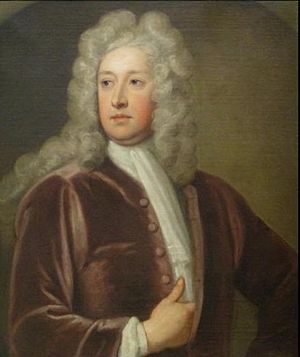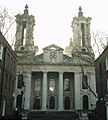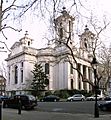Thomas Archer facts for kids
Quick facts for kids
Thomas Archer
|
|
|---|---|
 |
|
| Born | c. 1668 |
| Died | 22 May 1743 his house Whitehall
|
| Nationality | English |
| Occupation | Architect |
| Buildings | St. Paul's, Deptford St John's, Smith Square |
Thomas Archer (1668–1743) was a famous English Baroque architect. His work is sometimes not as well known as that of his friends, Sir John Vanbrugh and Nicholas Hawksmoor. However, Archer's buildings are special because they are the only ones by an English architect from that time to show ideas from Italian architecture.
Contents
The Life of Thomas Archer
Thomas Archer grew up at Umberslade Hall in Tanworth-in-Arden, Warwickshire. He was the youngest son of Thomas Archer, a country gentleman and a member of Parliament. His mother was Ann Leigh.
We don't know the exact date Thomas Archer was born. Records show he started at Trinity College, Oxford, on June 12, 1686, when he was 17. His tombstone also mentions his age. Based on these, he was likely born between June 1668 and May 1669.
After university, Thomas went on a "Grand Tour" of Europe. This was a long trip that young, wealthy men often took to learn about art and culture. He spent four years abroad. During this time, he was greatly inspired by the work of famous Italian architects like Bernini and Borromini.
Churches Designed by Thomas Archer
Thomas Archer designed several important churches. One of them was St John Evangelist in Westminster, London. This church has four towers, which were built to help keep the building stable. Some historians thought this was more likely than following Sir John Vanbrugh's style.
Another church was St Paul's, Deptford, built around 1750. It has grand, curved entrances that were quite unique for its time.
At St Philip's in Birmingham (now Birmingham Cathedral), you can see strong Italian influences. The church has high, decorated ceilings, a dome, and a special balustrade (a row of small pillars) on the roof. This was very unusual for English churches.
Both St John's and St Paul's were built for a special group called the "Commission for Building Fifty New Churches." This group was set up to build many new churches in London. A famous historian, John Summerson, said these two buildings were the most advanced examples of the Baroque style ever tried in England. Archer also helped improve designs for St Alfege's in Greenwich.
In Hale, Hampshire, Archer redesigned St Mary's Church. His own memorial, carved by Sir Henry Cheere, is inside this church.
Other Buildings by Thomas Archer
Thomas Archer also designed many non-church buildings. These included Roehampton House in Surrey and Welford Park in Berkshire.
He also worked on Chatsworth House. He designed the Cascade House, which features a waterfall, and the impressive north front of the main building.
From 1709 to 1711, Archer created a beautiful Baroque garden pavilion for the Duke of Kent at Wrest Park in Silsoe, Bedfordshire. After 1712, he designed Hurstbourne Priors in Hampshire.
In 1739, he helped start the Foundling Hospital in London. This was a charity for abandoned children. However, he was not the architect who built the hospital itself; that was Theodore Jacobsen.
Buildings Designed by Thomas Archer
Here are some of the buildings Thomas Archer designed or helped design:
- Chatsworth House, North front, Derbyshire, c. 1705
- Heythrop Hall, Oxfordshire, c. 1705
- St Philip's, Birmingham, 1708–1715
- Garden pavilion, Wrest Park, Bedfordshire, 1709–1711
- Roehampton House, Surrey, 1712
- Cliveden House, Service pavilions and the quadrant colonnades, Buckinghamshire
- Hurstbourne Priors, Hampshire, 1712
- St John’s, Smith Square, London, 1713–1728
- St. Paul's, Deptford, 1712–1730
- Hale Park, Hampshire, 1715
- St Mary’s Church, additions, Hale, Hampshire, 1717
- Harcourt House, Cavendish Square, London, 1722
- Hale Park, the house Archer designed for himself.
- Welford Park, remodelling of house, Berkshire, 1700
- Chicheley Hall, Buckinghamshire, c. 1703
- Parish church, chancel, Chicheley, 1708
- Addiscombe House, Croydon, Surrey, c. 1703
- Monmouth House, Soho Square, London, 1703
- Russell House, King Street, Covent Garden, London, c. 1704
- Cascade House, Chatsworth House, Derbyshire, 1705
- Hill House, Cain Hill, Wrest Park, Bedfordshire, c. 1710, demolished
- Bramham Park, Yorkshire, c. 1710
- Kingston Maurward, Dorset, 1717–1720
- Marlow Place, Buckinghamshire, 1720
- Chettle House, Dorset, c. 1730
- Monument to Susannah Thomas, Hampton Church, Middlesex, c. 1731
- Archer Memorial, St Mary’s Church, Hale, Hampshire
- Thomas Archer (his father) monument, St Mary Magdalene Church, Tanworth-in-Arden, Warwickshire
Gallery
-
Thomas Archer's garden pavilion at Wrest Park, 2007
See also
 In Spanish: Thomas Archer para niños
In Spanish: Thomas Archer para niños

















